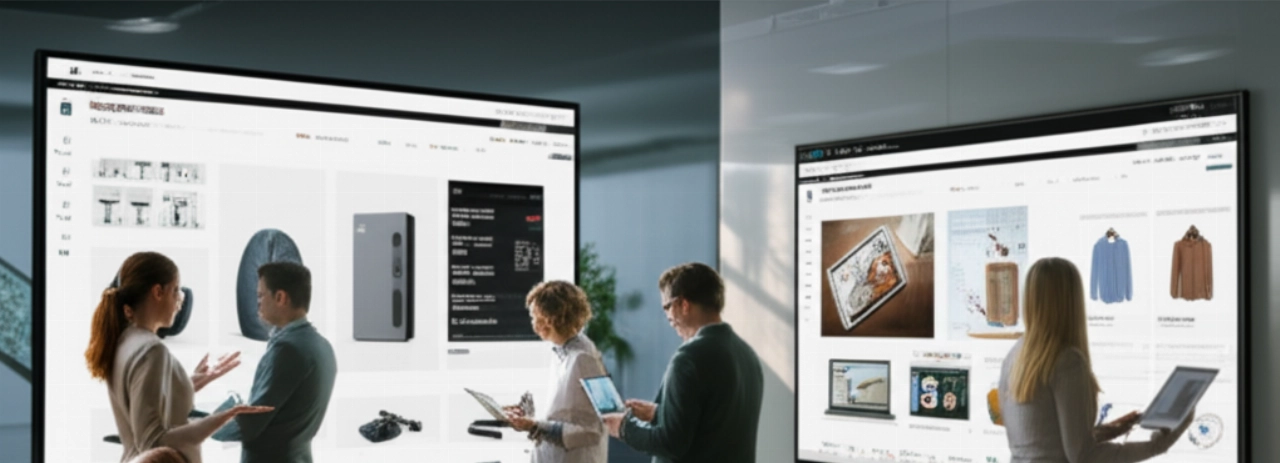In the relentless pursuit of digital market share, many enterprise leaders find themselves grappling with a fundamental question: How do we effectively manage both D2C (Direct-to-Consumer) and B2B (Business-to-Business) commerce channels without creating a labyrinth of technical debt and operational inefficiencies? The answer isn't about choosing one over the other; it's about understanding their distinct strategic imperatives and engineering a unified, yet differentiated, commerce ecosystem.
The common trap? Treating B2B as merely a more complex version of D2C, or vice versa. This 'one-size-fits-all' approach inevitably leads to a scalability ceiling, integration hell, and a performance bottleneck that chokes growth and erodes profitability. You’re not just building a website; you’re investing in the very nervous system of your enterprise.
At Commerce K, we don't just differentiate D2C from B2B; we provide the strategic framework to build a unified, scalable commerce ecosystem that drives predictable enterprise growth and eliminates costly replatforming cycles. This guide is your roadmap to achieving that clarity and unlocking your true digital potential.

Beyond the Transaction: Why D2C and B2B Demand Distinct Strategic Architectures
To truly master your digital commerce, you must first acknowledge the profound strategic differences between D2C and B2B. These aren't just minor feature variations; they dictate entirely different customer journey mapping, technology requirements, and operational workflows.
- Customer Journey & Relationships: D2C is often about impulse, emotional connection, and immediate gratification. B2B is about long-term relationships, complex approval workflows, and recurring orders based on contracts and negotiated terms.
- Pricing & Catalogs: D2C typically features straightforward, public pricing. B2B demands complex pricing models (tiered, volume, negotiated, customer-specific), custom catalogs, and often, quote management.
- Order Management & Fulfillment: D2C focuses on efficient single-item shipping. B2B involves bulk orders, partial shipments, credit terms, purchase orders, and intricate logistics tied to Order Management Systems (OMS) and Warehouse Management Systems (WMS).
- Integration Ecosystem: While D2C benefits from CRM and marketing automation, B2B is inextricably linked to ERP, PIM, CRM, and SCM systems for accurate inventory, pricing, and customer data. Disconnected systems lead to integration hell.
- Sales & Support: D2C often relies on self-service and automated support. B2B requires robust account management, sales rep portals, and dedicated customer service with access to order history, credit limits, and custom pricing.
Ignoring these distinctions is akin to trying to fit a square peg in a round hole. It leads to custom workarounds, bloated code, and ultimately, a system that buckles under the weight of its own compromises.

The 'Unified Platform' Myth: Avoiding Integration Hell and Scalability Ceilings
The allure of a single, monolithic platform promising to do everything for both D2C and B2B is strong. But for enterprise-level businesses, this often becomes the 'one-size-fits-all' trap. While some platforms offer B2B modules, they rarely provide the depth, flexibility, and performance required for true enterprise-grade operations.
The result? You hit a scalability ceiling. Your platform struggles with high traffic, complex product configurations, or the sheer volume of B2B transactions. Performance degrades, conversions drop, and your competitive edge dulls. This is the performance bottleneck that kills growth.
Instead of a monolithic 'unified' platform, the strategic antidote lies in a composable commerce approach. This means leveraging best-of-breed solutions for specific functions (e.g., a robust PIM for product data, a powerful ERP for financials, a flexible commerce engine for transactions) and connecting them via API-first principles. This headless architecture allows you to:
- Decouple Front-end from Back-end: Create distinct, optimized user experiences for D2C and B2B without impacting core business logic.
- Future-Proof Your Investment: Swap out individual components as technology evolves, avoiding costly, full-scale replatforming every few years.
- Scale Independently: Scale your D2C storefront for peak holiday traffic while your B2B portal handles complex order processing without interruption.
- Eliminate Technical Debt: Avoid forcing square pegs into round holes, reducing the need for costly custom development and maintenance.
This strategic shift is not just about technology; it's about building a resilient, adaptable digital foundation that can evolve with your market demands.

Engineering for Enterprise: Key Pillars of a Future-Proof D2C & B2B Ecosystem
Building a commerce ecosystem that truly serves both D2C and B2B requires a meticulous blueprint. Here are the critical pillars we focus on to ensure digital transformation and competitive advantage:
- Robust PIM Integration: A centralized Product Information Management (PIM) system is non-negotiable. It ensures consistent, rich product data across both channels, handling D2C marketing attributes and B2B technical specifications with equal ease.
- Seamless ERP Synchronization: Your Enterprise Resource Planning (ERP) system is the heart of your operations. Real-time ERP synchronization for inventory, pricing, and order status is paramount to prevent manual errors, ensure accurate fulfillment, and reduce the Total Cost of Ownership (TCO).
- Intelligent CRM Alignment: A powerful CRM (Customer Relationship Management) system, integrated with your commerce platforms, provides a 360-degree view of your customers. For B2B, this means tracking account history, sales rep interactions, and contract terms. For D2C, it's about personalization and loyalty programs.
- Automated Workflow & Approval Processes: B2B often requires complex approval workflows, credit checks, and custom quoting. Implementing workflow automation within your commerce platform streamlines these processes, reducing friction and accelerating sales cycles.
- Scalability & Performance by Design: From infrastructure choices to code optimization, every decision must be made with future growth in mind. This means architecting for high traffic, large catalogs, and complex transactions without compromising speed or user experience.
- Security & Compliance: Especially critical for B2B, ensuring compliance with industry regulations and robust security protocols is non-negotiable to protect sensitive customer and transaction data.
This isn't a checklist; it's a strategic framework for building a commerce engine that truly supports your enterprise ambitions.
Case Study: Unifying Disparate Commerce Silos for a Global Manufacturer
A global industrial equipment manufacturer faced a classic integration hell scenario. Their D2C site, built on an aging platform, was struggling with performance during peak sales, while their B2B portal, a custom-built solution, lacked modern features and was a constant drain on IT resources. Both operated in silos, leading to inconsistent data, manual order processing, and a fragmented customer experience.
Commerce K was engaged to provide a strategic roadmap. We didn't recommend a single, monolithic platform. Instead, we architected a composable commerce solution. We integrated a new, performant D2C storefront with a dedicated B2B portal, both connected to their existing SAP ERP and a new PIM system via a robust API layer. This approach allowed for:
- Distinct User Experiences: Tailored UIs and functionalities for D2C (e.g., visual configurators) and B2B (e.g., quick order lists, contract pricing).
- Unified Data: Real-time synchronization of inventory, customer, and order data across all channels, eliminating manual reconciliation.
- Enhanced Performance: A 60% improvement in page load times for D2C and a 35% reduction in B2B order processing time.
- Scalability: The new architecture could handle projected 5x traffic growth and 3x order volume without additional infrastructure investment.
This strategic approach transformed their digital presence from a liability into a powerful growth engine, demonstrating the power of understanding the nuances of D2C vs B2B ecommerce at an enterprise level.
From Complexity to Clarity: Partnering with Commerce K for Strategic Commerce Evolution
The journey from a fragmented, underperforming commerce landscape to a unified, scalable, and profitable ecosystem is complex. It requires not just technical prowess, but deep strategic insight into the unique demands of enterprise-level D2C and B2B operations.
At Commerce K, we don't just implement platforms; we act as your strategic technology partner. Our expertise lies in navigating the intricate challenges of enterprise-level complexity, from integrating legacy systems to architecting future-proof solutions. We understand the fear of a failed migration and the critical importance of a low TCO.
We provide the clarity, the blueprint, and the execution excellence to transform your digital commerce from a cost center into a powerful driver of market share and profitability. Our approach is rooted in understanding your unique business needs, not pushing a one-size-fits-all solution.
Frequently Asked Questions about D2C vs B2B Ecommerce
- Can one platform truly handle both D2C and B2B for an enterprise?
- While some platforms offer modules for both, a single monolithic platform rarely provides the depth, flexibility, and scalability required for true enterprise-grade D2C and B2B operations. A composable, API-first approach, leveraging best-of-breed solutions for each channel, often yields superior results and lower long-term TCO.
- What are the biggest risks of not differentiating D2C and B2B strategies?
- The primary risks include hitting a scalability ceiling, experiencing integration hell with backend systems, a significant performance bottleneck leading to lost conversions, and the 'one-size-fits-all' trap that stifles custom business needs. This often results in excessive technical debt and costly replatforming down the line.
- How does this impact our existing ERP/CRM integrations?
- A strategic approach to D2C vs B2B ecommerce emphasizes seamless integration with your existing ERP, CRM, PIM, and WMS systems. Rather than disrupting them, we architect solutions that leverage and enhance these core systems through robust API connections, ensuring data consistency and automated workflows.
- What's the typical ROI for investing in a tailored B2B/D2C solution?
- ROI varies significantly based on current pain points and strategic goals. However, clients typically see improvements in operational efficiency (reduced manual work), increased conversion rates, expanded market reach, lower total cost of ownership over time due to reduced technical debt, and enhanced customer satisfaction. We focus on measurable business outcomes.
- How do you ensure SEO continuity during such a complex strategic shift?
- SEO continuity is paramount. Our process includes meticulous SEO auditing, comprehensive URL mapping and 301 redirects, content migration strategies, and continuous monitoring throughout the project lifecycle. We prioritize maintaining and improving search rankings, ensuring your digital visibility remains strong during and after the transition.
Stop navigating technical debt and the confusion of disparate commerce strategies. Your business deserves a clear digital commerce roadmap that delivers measurable results and unlocks predictable growth. The first step isn't a quote; it's a no-obligation Scoping & Strategy Session with our senior architects. We'll help you map your potential, de-risk your investment, and identify the opportunities you're currently missing.
Click here, tell us about your project, and discover how a strategically engineered commerce ecosystem can transform your enterprise. Start building your future-proof commerce engine today.
Now that you understand the strategic distinctions between D2C and B2B, discover how we execute a seamless ecommerce migration service or explore the benefits of a headless commerce agency for ultimate flexibility.





